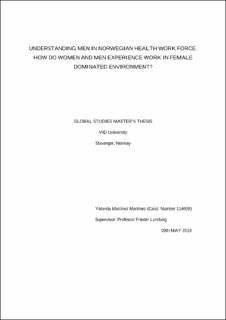| dc.description.abstract | To make the decision for selecting the concern to be investigated for my Thesis has not been too hard. I have always been attracted to explore various aspects of gender, mainly because my professional profile is complex. I’m a combat nurse, with the rank of captain of Spanish Armed Forces, currently with a leave of absence.
This professional career joins several interesting angles and sides to explore. For one side nursing is a care profession, typically performed by women since ancient times, on the other hand is the fact of being a soldier, the typical profession performed by men.
The fact of having experienced what it means to work in a male-dominated area during the first part of my professional career and having experienced the opposite situation with female domination during the last ten years has shaped my concern on this issue.
After living and working in several European countries (Spain, France and Norway), with a professional integration in almost all areas of health care, I wanted to deepen the analysis of my first observation since my professional beginnings in Norway:
Why the presence of men was so low in the health care sector? Why it was even lower than in other European countries?
Norway appears as an egalitarian model within the European panorama. Is this equality an illusion? Why the role of a male immigrant majority mainly of Asian origin filling the lack of male health worker presence in the area of nursing home care?
The central idea of this Thesis will therefore be “to understand and analyse how do health professionals, both men and women, feel and experience when working in a workplace dominated by women”, as well as to understand to what this scarce male presence is due.
The theoretical concepts about identity, self-image, masculinity, femininity, power, individualism, will be developed later in chapter 3, Theoretical Frameworks.
The empirical method developed in chapter 4 is the qualitative methodology, based on the information provided by the informants during individualized interviews, chosen mostly in the social health fields as the area of detoxification and rehabilitation in drug addiction.
During the time of performing the interviews, new elements appeared to be analysed, such as the adequacy of these policies of equality in number and the contribution of each of the genders in the professional field. And the most elementary but perhaps the most complicated to deepen “What makes these men decide to choose these eminently feminine works”.
Professional identity, power, status, masculinity, femininity will be developed in the topics of analysis. These concepts appear and play a leading role during interviews with different types of health professionals and non-health professionals.
As Lorentzen states, “Masculinity often manifests itself more clearly when it is compromised or in danger of becoming impoverished” (Lorentzen 2005: 9). The studies on masculinity developed in chapter 3 and the subsequent analysis of chapter 5 will shed more light on the concept of masculinity and hegemonic masculinity and how health men workers perceive their own image, and how they will mold their masculinity to adapt as minorities within a most.
Therefore to understand the men and women who work within the Health, with different academic backgrounds as nurse, assistant-nurse or social studies, but where all of them perform their jobs as care workers within a profession dominated by women, has been the clear object of my study.
Numerous studies have always been focused on how the man or woman experiences or feels in the diverse professional contexts dominated preferably by one of the genres woman or man.
The decision to explore from both angles, male and female, seemed necessary for me to get rid of an ethnocentric perspective that involves studying only one of the two genres. The interviews were also extended to non-health personnel, predominantly technicians such as engineers or personnel belonging to the “Menn i Helse” project from various areas of the Petroleum industry, dominated in these cases by men.
Therefore, after an introduction, theoretical foundation and explanation of the method, three chapters will be developed by analysing all the information provided during the interviews, providing at the end final conclusions.
This analysis will be focused on:
Analysis I: Health personnel interviews. Talks about their decisions to study a profession dominated by women, and the weight of cultural influence, masculinity, stereotypes, migration.
Analysis II: Interviews to participants of project “Men i Helse”. Reflections on complementarity and individualism.
Analysis III: Interviews to engineers. Self-image and image projection, identity, power, status. The chapter 6 will try to answer these questions:
• Is the low status and limited power, the main concern that limits the decisions of men to dedicate themselves to the care professions?
• Is the small number of men working in health what generates discomfort provoking a limitation of men that decide to study these professions?
• How is masculinity / femininity altered or modified when they develop these jobs?
• What does it mean to increase the male presence?
Finally some recommendations will be proposed. | en_US |
